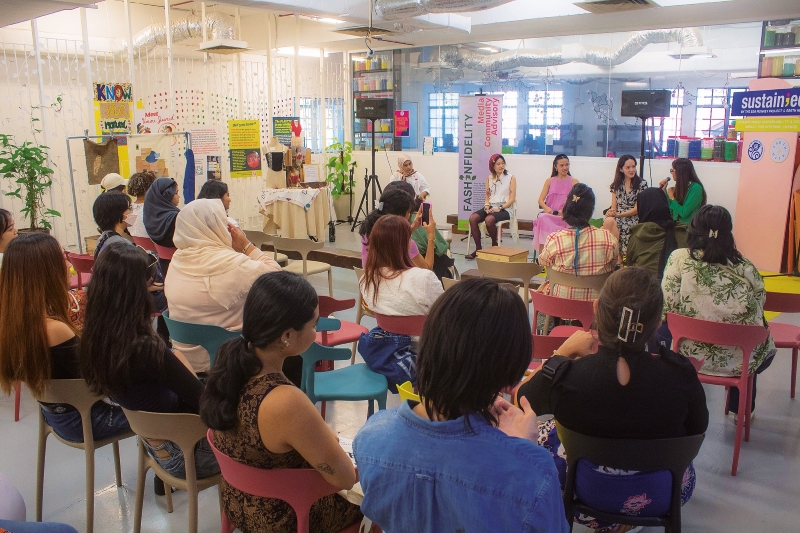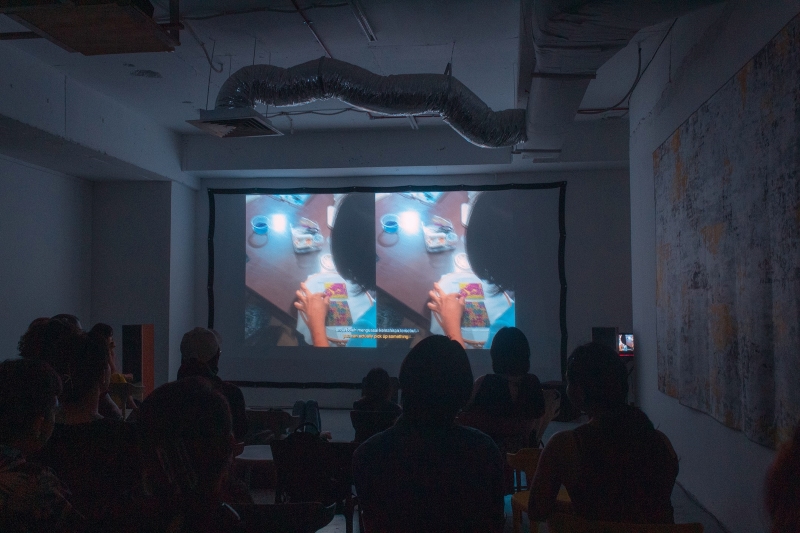
One key message Fashinfidelity hopes to spread is how to help people reflect on their purchasing patterns (Photo: Shahrill Basri/ The Edge Malaysia)
In the 1995 science fiction film Powder, Jeff Goldblum who plays Donald Ripley, says the following while in conversation with the titular character, who has supernatural intellect and abilities: “It has become appallingly clear that our technology has surpassed our humanity.”
Like many other potent moments from film and TV, Ripley’s observation foretold the rapid advancement of technology and the grave issues of accelerated environmental and social damage that would swiftly follow.
One trade heavily affected by disproportionate technology-society evolution rates is fashion. In Malaysia, conversations and efforts towards sustainable clothing production and consumption have gained significant traction only in recent years. Much of the ongoing initiatives remain at grassroots level, with the appearance of physical and online thrift stores, community-organised clothing swaps and independent designers specialising in reworked clothing.
Despite general society’s increased interest in sustainability and the desire to implement it in everyday life, living in an age of hyper-consumerism and microtrends spread via fast-paced social media updates make it hard to slow down and downsize our wardrobes in a healthy, meaningful way. And without the appropriate education and resources offered by the government, schools and, most importantly, manufacturers themselves, how much can the average person be empowered to do?
Enter Fashinfidelity, a network and content producer focused on educating audiences on the various niches of sustainable fashion with a Southeast Asian focus. Founded in 2018 by sustainability specialist and consultant Najah Onn, the initiative uses social media as its primary platform to disseminate information and engage with users.
Today, there are countless fashion and style accounts online that have a strong environmental-consciousness focus. What sets Fashinfidelity apart is its founder’s sure footing in sustainability, something she has lived and breathed since childhood.
panel_1_audience_from_back_2.jpg

“I’ve always been into greener lifestyles and conscious consumerism because of my grandma,” Najah says, noting how the matriarch would reuse wastewater for gardening and make household tools and trinkets out of old pots and containers. “She is the influencer in my life and the original ‘DIY queen’ in my family.”
Her conscious upbringing means that sentimentality for one’s belongings, including clothes, is a cornerstone of how Najah practises sustainability in daily life. And one key message Fashinfidelity hopes to spread is how to help people reflect on their purchasing patterns.
It is important to note that Fashinfidelity’s main goal is not to do away with fashion, the art and culture it embodies or the jobs it creates. Rather, it is about style enthusiasts and professionals having an accessible and reliable source of information to effectively slow down the rate at which clothing is produced, bought and discarded.
“We don’t judge people for their consumption,” Najah explains. “We just advocate [that they] be more mindful and slow down the pace. We believe clothes should be treasured and make us feel joy. Some people buy into trends for a cheap price and end up with things they don’t even feel good in. Perhaps for a photo, they do, but they would never wear it again after because it isn’t comfortable or doesn’t fit right.”
Beyond its social media content, Fashinfidelity also works closely with designers, manufacturers and recyclers to implement sustainability “from the ground up”. In fact, the organisation is currently fundraising for a comprehensive online platform that will include a directory of resources to answer the questions mainstream fashion prefers to keep secret.
“I have people asking me all the time where they can find things like organic cotton. The problem with fashion is information like this is seldom shared by the people who have the answers. For example, students in fashion school need to provide textiles for graduate collections and are buying brand-new rolls of fabric when there is so much deadstock stuff piling up in warehouses that they don’t know about because there is no reliable source to tell them where and how to get these things,” Najah says.
wearers_keepers_1.jpg

The news and media section of this platform aims to help people stay up-to-date with all the latest happenings in the sustainable fashion scene around them. “You can go on it and see that there’s a clothing swap next weekend, and it will tell you whether it’s near where you live and easy to get to,” she explains. In addition, the site provides a platform for independent communities and activists into sustainable style “to do the good things they do and connect them with a bigger audience”.
In February, the group held its very first community event, a notable step into a new era six years after its establishment. Titled “Wardrobes of the Future”, it took place at Sustain.ed KL, a hub for all things sustainability, located beside Pasar Seni in the heart of the city. Organised in collaboration with local experts and second-hand clothing curators, and hosted by a team of volunteers, the affair featured pre-loved clothing booths, quiz activities, a sarong styling workshop, talks and panel discussions, as well as documentary screenings.
At one booth in particular, the Know Your Fabrics quiz allowed visitors to feel a range of clothes and guess their textile make-up without peeking at the tags. It was a big hit and showed how little most people know about the clothes they wear. This kind of interactive fashion education has the potential to be incorporated into school curriculums, and instil mindfulness in children from a young age.
Of course, “touch goes back to sentimentalism”, Najah comments, recalling how she would run her hands along her grandmother’s clothes and feel connected to her time, when clothing was made to last and maintain special meanings and memories for the wearer. “I don’t think I could have that connection with something I bought randomly from H&M.”
As Fashinfidelity continues to grow, she is keen on deepening efforts to connect the sustainable fashion community with audiences and better equip individuals across all levels, from educators and seamstresses to textiles suppliers and budding designers. The organisation also wishes to offer its ESG consultancy services to small and medium-sized businesses looking to uplift their profile in a holistic way, as well as focus on business-to-business efforts for companies, government and manufacturers in their content for the year. Followers who enjoyed the Wardrobes of the Future should keep their eyes peeled for future event announcements, of which Najah promises there will be plenty.
This article first appeared on Apr 15, 2024 in The Edge Malaysia.


